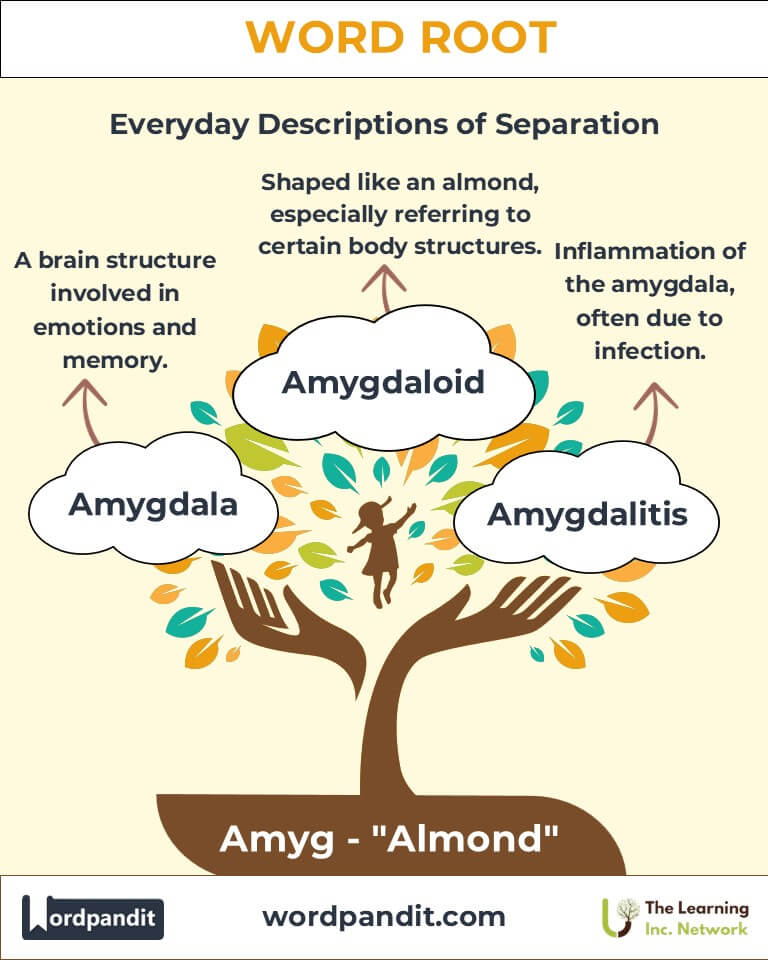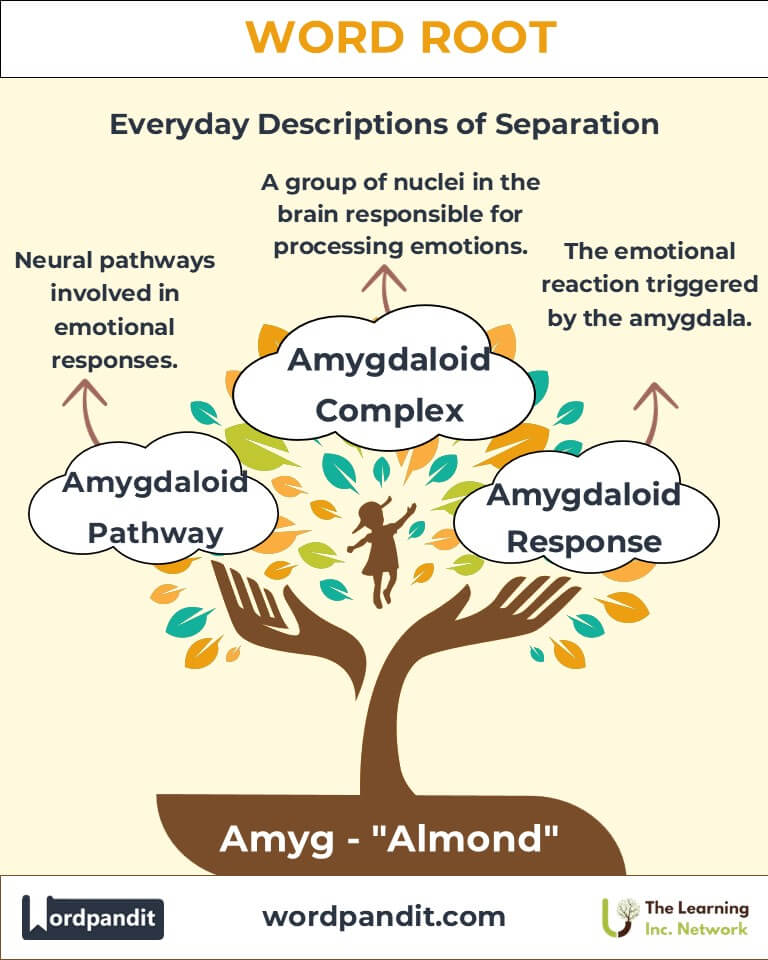Amyg: The Almond Connection in Language and Science
Delve into the fascinating world of "Amyg," a root derived from the Greek word amygdalē, meaning "almond." This root provides the foundation for terms in anatomy and geology, such as the amygdala and amygdaloid, bridging the gap between language, biology, and the natural world.

Table of Contents
- Introduction: The Essence of Amyg
- Etymology and Historical Journey
- Mnemonic: Unlocking the Power of Amyg
- Common Amyg-Related Terms
- Amyg Through Time
- Amyg in Specialized Fields
- Illustrative Story: Amyg in Action
- Cultural Significance of the Amyg Root
- The Amyg Family Tree
- FAQs about the Amyg Word Root
- Test Your Knowledge: Amyg Word Root Quiz
- Conclusion: The Living Legacy of Amyg
Introduction: The Essence of Amyg
The root "Amyg" evokes the almond, both in shape and symbolism. Pronounced "AY-mig," it stems from the Greek word amygdalē. In scientific contexts, it finds use in describing almond-shaped structures like the amygdala in the brain or amygdaloid formations in geology. This root bridges language, anatomy, and geology, offering insights into both human cognition and the Earth’s wonders.

Etymology and Historical Journey
"Amyg" traces its origins to ancient Greek, where amygdalē referred to the almond nut and later the almond tree. The term traveled through Latin into Middle English, shaping words associated with almond-like forms. In modern science, it plays a pivotal role in naming structures in both biology and geology, reflecting its descriptive power.
Mnemonic: Unlocking the Power of Amyg
Visualize an almond resting within the intricate folds of the brain. This image connects the root "Amyg" to its anatomical and geological references.
Mnemonic Device: "Think of Amyg as the almond in science: tiny yet significant in form and function."
Common Amyg-Related Terms
- Amygdala (ah-MIG-duh-luh)
- Definition: A small, almond-shaped brain region involved in emotions, particularly fear and pleasure.
- Example: "The amygdala activates when you feel fear, preparing your body to respond."
- Amygdaloid (ah-MIG-duh-loyd)
- Definition: Resembling or shaped like an almond; often used in geology to describe certain rock formations.
- Example: "Amygdaloid basalt contains almond-shaped cavities filled with minerals."
- Amygdalitis (ah-MIG-duh-LY-tis)
- Definition: Inflammation of the tonsils, historically linked to their almond shape.
- Example: "Recurring amygdalitis led to the decision to remove her tonsils."
- Amygdaloid Nucleus
- Definition: A cluster of neurons in the brain forming part of the amygdala.
- Example: "The amygdaloid nucleus is essential for emotional processing."
Amyg Through Time
- Ancient Medicine: Early anatomists likened the tonsils to almonds, coining terms like amygdalitis.
- Modern Neuroscience: The amygdala became central to studies on fear and emotional regulation in the 20th century.
- Geological Evolution: Amygdaloid rocks, first described in the 19th century, remain a focus in mineralogy.
Amyg in Specialized Fields
- Neuroscience:
- Amygdala: Critical for studying emotional responses and disorders like PTSD.
- Relevance: Research into the amygdala informs therapies for anxiety and depression.
- Geology:
- Amygdaloid Basalt: Formed from lava, featuring almond-shaped cavities later filled with minerals like quartz or calcite.
- Relevance: Used to study volcanic activity and mineral formation.
- Medicine:
- Amygdalitis: Though less common due to medical advancements, its study provided insights into infections and immune responses.
Illustrative Story: Amyg in Action
In a bustling neuroscience lab, Dr. Elena Alvarez studied the amygdala’s role in stress responses. One day, she received a unique rock sample labeled "amygdaloid basalt." Fascinated by its almond-shaped cavities, she realized a connection: both the brain and Earth carry almond-shaped treasures central to their respective functions. This inspired a cross-disciplinary lecture celebrating the Amyg root’s impact on science.
Cultural Significance of the Amyg Root
The almond has long symbolized wisdom, rebirth, and delicacy. In literature, almonds often represent awakening, echoing the amygdala's role in emotional awareness. The geological use of "amygdaloid" ties this cultural reverence to Earth’s formation, merging natural and intellectual traditions.

The Amyg Family Tree
- Mand (Latin: "to chew"):
- Mandible: Highlighting its almond-like curve in some depictions.
- Cary (Greek: "nut"):
- Caryopsis: Grain or fruit resembling a seed, connecting almonds to other nut-like shapes.
- Nucle (Latin: "kernel"):
- Nucleus: Often almond-shaped in cross-sections, linking structure and function.

FAQs About " Amyg "
Q: What does "Amyg" mean?
A: "Amyg" means "almond" and is derived from the Greek word amygdalē, which originally referred to the almond nut or tree. This root is used to describe objects, structures, or formations resembling the almond’s distinctive shape.
Q: Why is the amygdala named after almonds?
A: The amygdala, located in the brain, is a small, almond-shaped cluster of nuclei critical for emotional processing. Early anatomists, observing its resemblance to an almond, coined the name based on its shape.
Q: What are amygdaloid rocks?
A: Amygdaloid rocks are volcanic rocks characterized by almond-shaped cavities or vesicles that were formed when gas bubbles were trapped in lava. Over time, these cavities are filled with minerals such as quartz, calcite, or zeolites, creating unique formations.
Q: Is "amygdalitis" still a commonly used term?
A: While "amygdalitis" is an older term referring to tonsil inflammation, modern medicine more frequently uses "tonsillitis." The connection lies in the almond-shaped appearance of the tonsils, inspiring the term.
Q: Can almond shapes occur in contexts other than the brain and rocks?
A: Yes, almond-shaped forms appear in various contexts, such as the tonsils in medicine, certain seeds, or even architectural designs. The term "amygdaloid" can describe any object resembling an almond.
Q: What minerals commonly fill amygdaloid rocks?
A: Minerals such as quartz, calcite, chlorite, and zeolites often fill the cavities in amygdaloid rocks. These formations are significant in geology for understanding volcanic activity and mineral deposition.
Q: Does the amygdala control only fear?
A: No, the amygdala processes a wide range of emotions, including fear, pleasure, anger, and reward. It is also crucial for memory formation, especially memories associated with emotional experiences.
Q: Are almond shapes significant in other scientific disciplines?
A: Yes, almond-like shapes appear in various fields, such as botany (seeds), geology (amygdaloid rocks), and anatomy (tonsils and amygdala). This recurring shape often represents functionality or formation influenced by natural processes.
Test Your Knowledge: " Amyg " Mastery Quiz
1. What does the root "Amyg" mean?
2. What is the amygdala associated with?
3. Amygdaloid rocks are characterized by:
4. What does "amygdalitis" describe?
5. Which mineral is commonly found in amygdaloid rocks?
Conclusion: The Living Legacy of Amyg
The root "Amyg" reveals the interconnectedness of language, science, and culture. From the emotional depths of the amygdala to the geological wonders of amygdaloid rocks, this almond-shaped root continues to shape our understanding of the world. Explore "Amyg," and uncover its hidden treasures in fields ranging from neuroscience to mineralogy.












